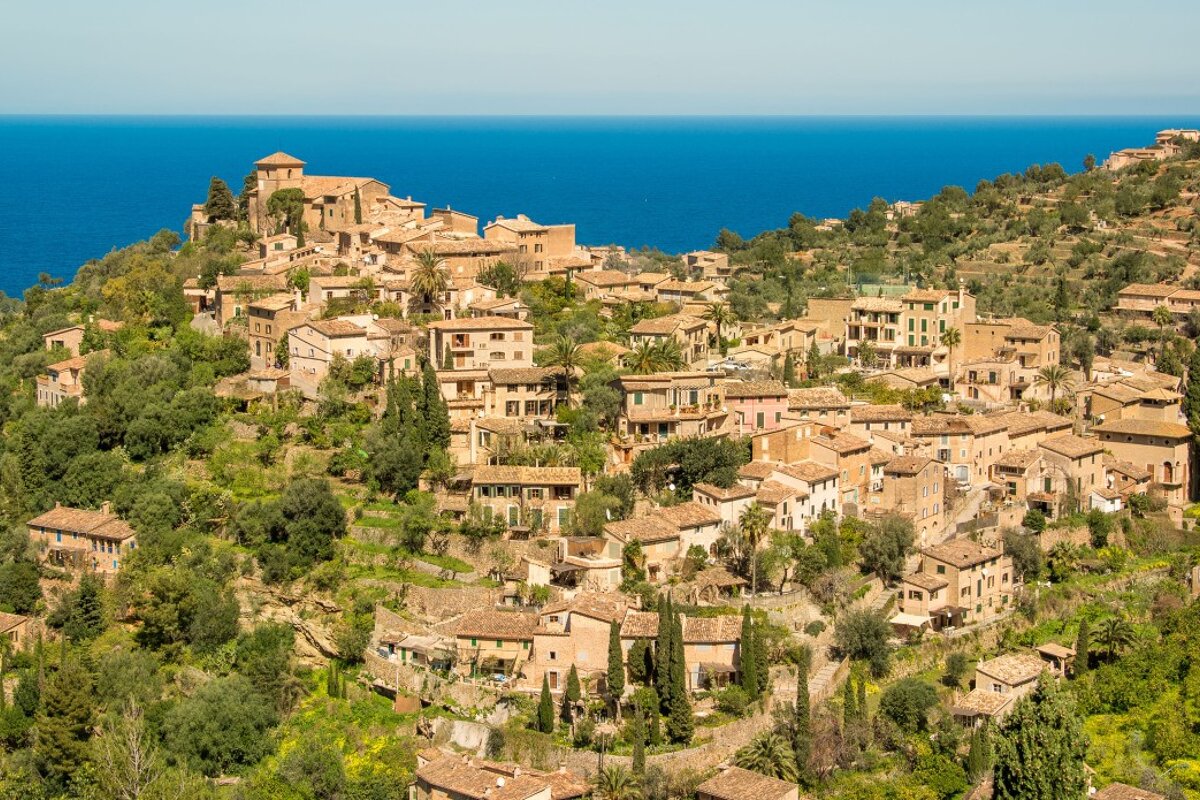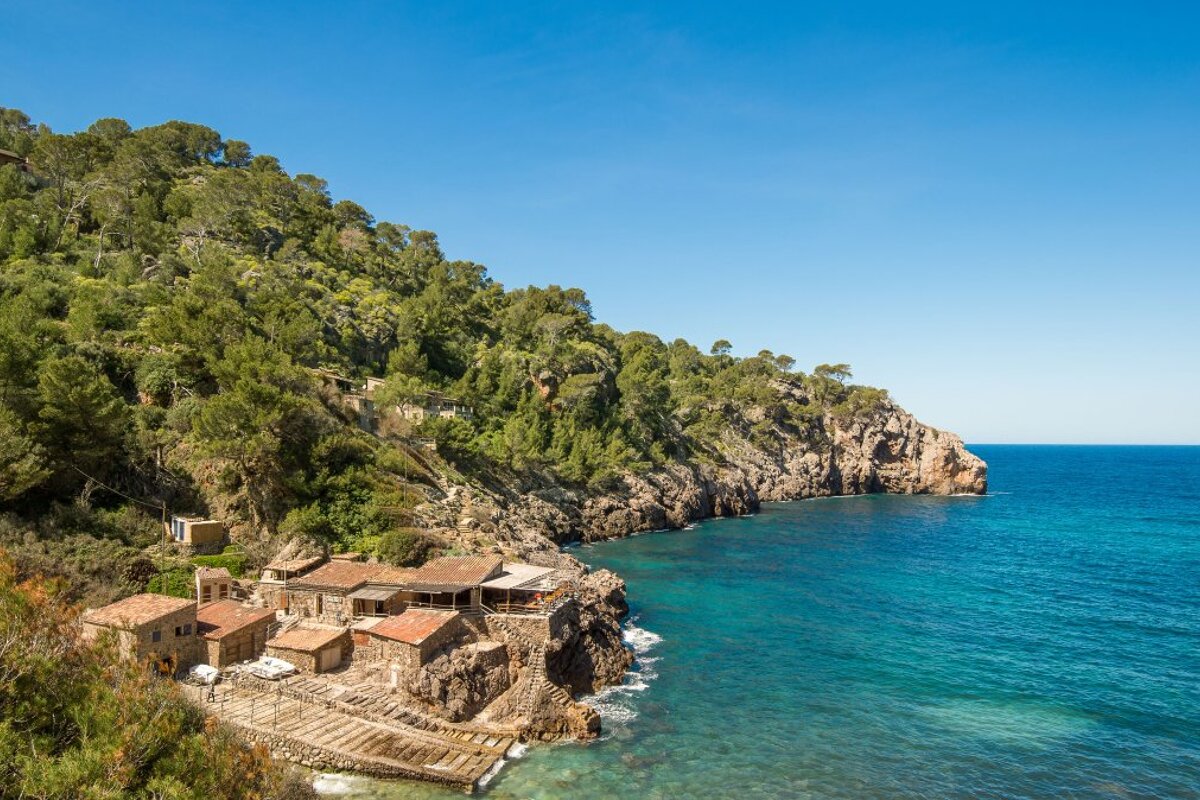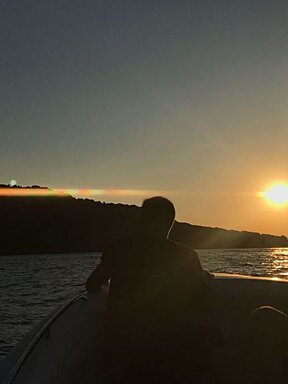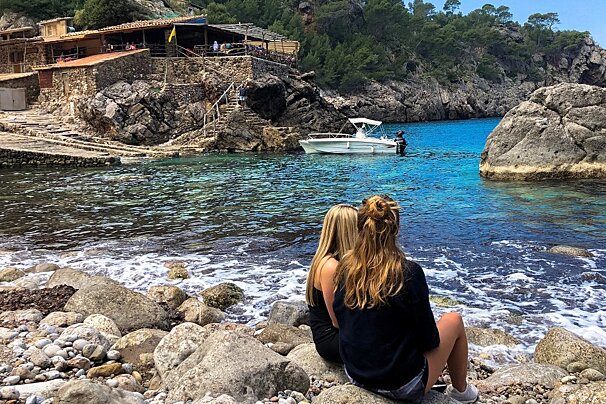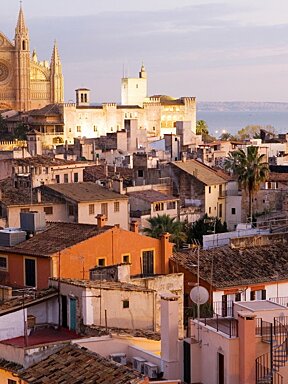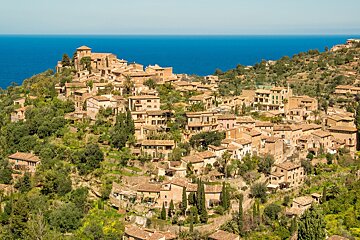
© JBennett
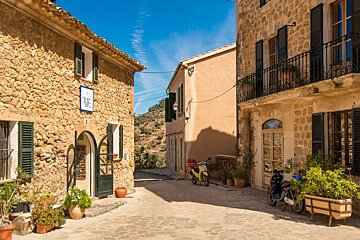
© JBennett
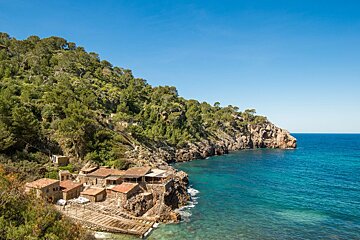
© J. Bennett
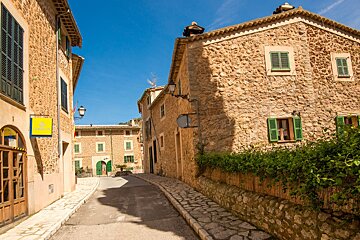
© JBennett

© Jose Rains
Deia, Mallorca
Pretty coastal village on the west coast of Mallorca
Deia is an idyllic village of green-shuttered, honey-coloured houses that has become a millionaires' hideaway in the shadow of the Teix mountain, part of the Serra de Tramuntana mountain range. Although it could have been just another pretty Mallorcan village in the west of Mallorca had Robert Graves not decided to make it his home...
The English poet and novelist first moved here in 1932 with his mistress Laura Riding and returned in 1946 with his second wife. Muses followed, friends came to stay and, before long, Deia had established a reputation as a foreign artists' colony. However, Graves was hardly the first to discover Deià, an 1878 guidebook noted its "collection of strange and eccentric foreigners" and it has stayed that way ever since.
Today the village is still very much an artist’s town with a number of art galleries and gift shops, along with a good selection of restaurants while controlled urban expansion has meant that this little village has maintained its traditional beauty and charm. Now it is on every tourist itinerary as a prime example of 'the other Mallorca' and it has even become a popular haunt for the rich and famous, including visitors like Richard Branson, Princess Diana, Bob Geldof and Andrew Lloyd Webber. Foreign residents, which make up half of its population, are certainly of the affluent type, evident in the average house price for the municipality. These expats not only respect but immerse themselves in the traditional Mallorcan life created and preserved by locals from the area.
Being a part of the Serra de Tramuntana mountain range, awarded World Heritage Site status, means that Deia is surrounded by some of Mallorca’s finest landscapes. There is a relaxed vibe here but, at the same time, it is a popular place for cycling and hiking enthusiasts to base themselves.
History & Culture in Deia
The name of Deià (or 'Deya') comes from the time of the Moorish conquest of Mallorca, back between the 10th and 13th centuries. The Muslims called the area 'Ad-Daya' which means 'village' and, during their domination of the island, they created the terraced irrigation systems that allowed the steep hillsides to be cultivated for farming. Olive trees flourished up to an altitude of 600 metres, and today cover much of the hillsides above the town.
After the Christian conquest in 1229, Deià was presented to the Count of Rosselló and became a part of Valldemossa. In fact, the towns of Valldemossa and Deia formed a single municipality for over three centuries. However, after decades of fighting for independence, Deia became an individual town in 1583. On this date, its inhabitants began building a church on a nearby hill. In the centuries that followed, the village flourished due to its olive cultivation, along with fishing and farming of citrus fruits, and the population grew to 1500.
Since the 19th century, Deià has famously attracted artists, musicians and those in search of a bohemian lifestyle. The Archduke Luis Salvador of Austria was so captivated by the area that he purchased several estates: Miramar, now a hotel, and Son Marroig, a wedding venue that also hosts annual festivals and concerts. Robert Graves was a famous resident and his house, Ca N'Alluny, has been turned into a museum for the public to visit.
Beaches in Deia
From Deià you can walk down to Cala Deià, a small shingle beach set in an attractive cove where local artists still continue the Graves tradition of naked swimming and long parties at weekends. There are two restaurants here, with fresh fish as their speciality although they are only open during the summer season.
Events in Deia
The main event in town is the Deià International Music Festival which takes place every summer between May and September across some of the village's most iconic buildings. It features an array of different music concerts taking place throughout the festival, from solo pianists to full orchestras.
Things to do in Deia
A trip to Deià is all about getting some downtime in a peaceful setting, sitting on terraces, soaking up the Mediterranean sun and enjoying spectacular views across the mountains. At the same time, being located in Mallorca’s legendary Serra de Tramuntana mountain range means Deià is also a wonderful base for the outdoorsy type who enjoy hiking, cycling and more.
Hiking
There are plenty of hiking trails in the hills above Deià, thanks to the ancient paths that linked many of the quaint mountain villages in the Serra de Tramuntana. Check at the tourist office for maps and trail information but the most famous is the GR221 Stage 3A (the dry stone route) from Valldemossa to Deià. We recommend catching the TIB bus 210 from Deià down to Valldemossa to start the route, then return to Deia on foot along the ancient paths. Starting from the centre of Valldemossa, head uphill through the woods along stony old mule tracks and make sure you take time to stop and soak up the scenery at the viewing points out over Valldemossa and through to the bay of Palma. For part of this trail, you will join the Archduke's bridleway, an old cobbled path built by the Austrian Archduke Ludwig Salvator in the 1860s to 70s along Mallorca’s stunning coastline. It’s a 5-hour walk, so not for the faint-hearted but well worth it.
Cycling
Many of the most popular cycling trails on the island travel straight through the village of Deià which means cyclists donning their best lycra are a common sight in the cooler months on the island. The twisting ups and downs provide thigh-busting workouts and, whether you fancy the coastal route or exploring some of the inland beauty spots, there are dozens of routes to choose from.
Robert Graves Tour
A visit to Robert Graves old house should be on your to-do list if you are visiting Deià. The house will transport you back in time to when he was living there as it retains the atmosphere it had when Graves was at the height of his creativity. It is filled with his personal belongings including a jam-packed guestbook. The gardens are also worth a trip, filled with orange, olive, lemon and almond trees. If you are a Robert Graves fan then walk the Carrer es Puig, Deià's only real street, passing the ceramic Stations of the Cross, to reach the 15th-century Parish Church of San Juan Bautista and you will find the small cemetery where Graves is buried. His headstone, like many others, is inscribed in simple handwriting set into the drying concrete - "Robert Graves, Poeta, 1895-1985". If you want to know more, read "Wild Olives - Life in Majorca with Robert Graves" by his son William Graves.
Archaeological Museum
There is an Archaeological Museum, Es Clot, which was founded by Dr. William H Waldren and is set in an old mill. The exhibitions contain examples of findings from important local sites on the island such as the Son Mullet Caves, including the remains of 'myotragus' (mountain goat, now extinct).
Arts & crafts
The luxury Hotel Belmond La Residencia welcomes visitors to its intimate gallery space called Sa Tafona. Here you can admire works from cherished artists Joan Miró, David Templeton and Arturo Rhodes who have spent time in Mallorca. Exhibitions change monthly and opening nights are a great social occasion. If you are looking for a gift to take home from Deià, Ceramics by Joanna is a popular gift shop selling ceramics, from bowls and plates through to tiles.
Dining in Deia
Fine restaurants
Deià is home to some first-class restaurants catering for the affluent patrons that the village tends to attract. The crème de la crème is the Michelin starred Es Raco d'Es Teix which serves up swanky Mediterranean-Mallorcan cuisine using fresh seasonal ingredients. It also boasts a splendid view over the village. El Olivo in Hotel Belmond La Residencia is also a sophisticated affair, where you can expect to enjoy a superb gastronomic experience.
Paella & tapas
For a more rustic local Mallorcan experience, try Restaurante Sebastian, in a 250-year-old former stable. Skilful restoration has preserved the original stone walls and traditional Mallorcan benches, and the elegant candlelit atmosphere is very relaxed but draws a stylish crowd who feel very much at home as they indulge in some local and international-inspired dishes. For more relaxed tapas dining, head to El Barrigon Xelini which is again housed in a building drenched in history. If you are after paella or other local dishes in a no-frills setting, Sa Vinya might take your fancy.
Restaurants with a view
Just outside of town, it’s well worth heading down to Cala Deià to indulge in some spectacular sea views and superb seafood. Ca’s Patro March is the most famous restaurant here thanks to being featured in the award-winning BBC TV series The Night Manager. An isolated restaurant perched on the rocks overlooking the Cala where the dramatic fake kidnapping took place. Alternatively, on the other side, there’s the equally pleasant Can Lluc Restaurant, which features the same rustic décor, pleasant views and traditional seafood cuisine. If you are willing to travel further afield, the Restaurante Mirador Na Foradada offers breathtaking views and can be found on the road to Valldemossa, set high up on a cliff offering typical Mediterranean cuisine and splendid views over the peninsula.
Hotels in Deia
Luxury hotels
The most famous hotel in Deià is, of course, the five-star Belmond La Residencia which was formerly owned by Sir Richard Branson. Between olive groves and citrus trees, this historic site dating back to the 16th century provides luxurious accommodation and facilities on the outskirts of town. The building has been tastefully restored to emulate its historic roots and each room is individually decorated with antique furniture and luxury features. Its highlights include 2 swimming pools, tennis courts, a top-notch spa and a permanent art and sculpture exhibition.
Another popular hotel on the other side of town is Es Moli, set within a 17th-century mansion that provides 87 bedrooms decorated in a traditional Mallorcan style. It has everything you need for a relaxing holiday on the island including a tennis centre, a large swimming pool, restaurants, bars and live entertainment in the evenings. One feature that makes it stand out from the crowd is its own rocky cove within the grounds.
Boutique hotels
There are a few boutique-style hotels in and around the town. Sa Pedrissa is set in a renovated country house dating from the 17th century and still retains many characterful original features. It offers a more intimate vibe and, due to its location on the headland overlooking Deià, it claims amazing views out to sea.
Budget-friendly hotels
If you want to be in the centre of Deià, there are a couple of small hotels which are a little more budget-friendly. Try Hotel des Puig which houses simple, traditionally furnished rooms, a lovely swimming pool and fine views over the mountains. If an adults-only hotel appeals to you, then perhaps Costa d'Or Hotel could be the one for you. Set just outside of the village in a pine forest and a secluded cove just a short walk away, this is the perfect escape. This hotel mixes contemporary fixtures and fittings with more traditional features to create a luxury hotel experience. It has a lovely swimming pool area with panoramic views over the bay and tennis courts to keep its more active visitors happy.
How to get to Deia
By car
Being in the west of Mallorca, Deià is a 45-minute drive from Palma airport. Leaving the airport, head towards Palma on the Ma-19, then take the Ma-20 ring road around the city. To the north of the city, take exit 5B from the Ma-20 along the Ma-1110 into the Serra de Tramuntana mountain range then, from the pretty mountain village of Valldemossa, Deià is signposted along the Ma-10 and is just a further 10-minute drive.
Public transport
Whilst there are no direct buses to Deià from the airport, you can catch bus number 1 to the bus station at Plaça d'Espanya, then the direct 210 TIB bus which leaves once per hour and takes under an hour to get to Deià.
